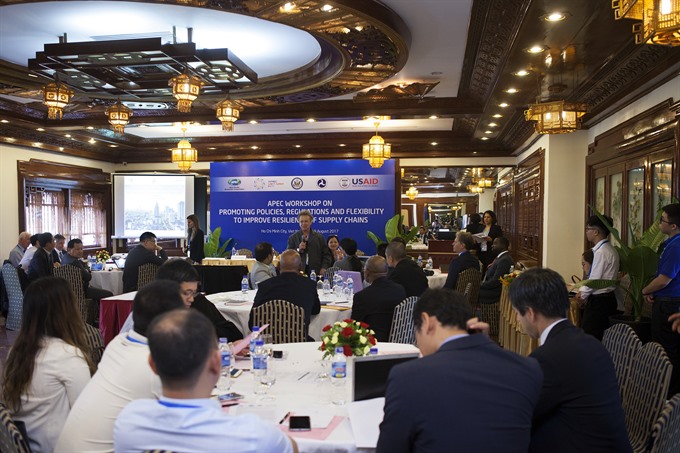 Society
Society

" />The first of the third APEC Senior Officials Meeting (SOM 3) and related meetings began in HCM City today.
 |
| The Transportation Working Group discussed policies, regulation and flexibility to help improve the resilience of the supply chain at a workshop within the framework of APEC’s Third Senior Officials Meeting (SOM3) on August 18 in HCM City. — VNA/VNS Photo by Lê Minh |
HCM CITY – The first of the third APEC Senior Officials Meeting (SOM 3) and related meetings began in HCM City today.
The Sub-committee on Standards and Conformance (SCSC) began with two workshops on “Best conformity assessment implementation on smart cities in APEC region” and “Facilitating trade in information and communications technologies products through encouragement of electronic labelling best practices.”
The conference on smart cities in the APEC region is being attended by more than 100 delegates from over 10 APEC members, including Việt Nam, China, Japan, Thailand, and the US.
Experts and officials shared their experiences and issues in developing smart cities, including updates on international standardisation organisations’ international standards related to smart cities.
The second SCSC workshop focuses on e-labelling and the ICT sector.
It provides an overview of electronic labelling with a focus on emerging trends in e-labelling and the benefits of e-labelling for ICT trade, and highlights international standardisation efforts.
The automotive dialogue (AD) also got under way with a workshop on “The impact of Government policy instruments on promoting new energy vehicles”, attracting participants from over 10 APEC members including Malaysia, the US and Việt Nam.
Besides discussing the main topic, the workshop also shared the strategies and practices behind e-scooter promotion in Taiwan.
Chinese delegates spoke about the status of and trends in the new energy vehicle policy.
Comparisons between automotive tax policies used to promote new energy vehicles in APEC will be discussed this afternoon.
The first day of the Expert Group on Illegal Logging and Associated Trade (EGILAT) began with a workshop on customs best practices to identify illegal timber and wood products.
The workshop focuses on protocols and methodologies for targeting illegal wood shipments, best practices for forensic timber identification for customs professionals; legal wood products certification programmes; protocols for documentation and date review to monitor compliance and wood product legality.
Nguyễn Văn Hà, deputy general director of the Việt Nam Administration of Forestry, said : “The workshop is the place where APEC members can share experiences, best customs practices and tools to help them identify illegal timber so as to completely eliminate it from the supply chain and from the global timber trade act.”
Also this morning senior APEC officials considered five important topics in the first sessions taking place at the Rex Hotel .
They discussed counter-terrorism, noting with concern the growing threat of terrorism in the APEC region stemming from lSlL, Al-Qaida and other organisations, cross-border travel of foreign terrorist fighters, spread of radicalisation through the Internet, and new sources and channels of terrorist financing.
They encouraged APEC members to continue to take concerted action in response to the terrorist challenges in the region based on APEC’s Consolidated Counter Terrorism and Secure Trade Strategy.
Port service safety
Eighty delegates from the Transportation Working Group gathered this morning for the 10th APEC Port Services Network (APSN) Meeting to discuss measures to enhance the safety of transportation in the Asia-Pacific region.
The meeting focused on facilitation of domestic policy regulations, development of intermodal supply chains and secure transport activity, and integration of corporate social responsibility.
It also discussed building the capacity of all stakeholders to help them reach the eventual goal of free and open trade.
Jerry Rysanek, APSN’s senior consultant, said: “Regulatory regimes on safety of dangerous goods at APEC ports should be harmonised.
“It is necessary for the participating economies to update the latest dangerous goods guidelines.”
To achieve the highest degree of harmonisation, APSN will compile best practices on handling of dangerous goods at ports in the APEC region and submit them to the council for consideration for the next meeting, according to the Secretariat.
The meeting also reviewed outcomes of the previous workshop on restructuring of shipping and port industry that took place in HCM City on August 15-16.
Delegates called for measures by individual economies to strengthen security of all modes of transportation.
The meeting will discuss the action plan for 2018 this afternoon and review and update the ASPN Five-Year Strategic Plan for 2014 – 2018, which the Secretariat said would be important for setting the direction of the next meeting.
Medical products
The Regulatory Harmonisation Steering Committee (RHSC) today unveils the Strategic Framework Regulatory Convergence for Medical Products by 2020.
Adopted in 2010 by the RHSC and the Life Science Innovation Forum in Japan, it provides the basic proposal and rationale for achieving regulatory convergence for medical products within the bloc by 2020.
The purpose of the strategic framework is to outline a strategic multi-year approach for meeting this objective in support of the broader objectives of improved public health and economic development.
Each economy will determine the level of convergence it desires, develop specific strategies to promote regulatory convergence and set its timetable in the context of its own regulatory system and socio-cultural objectives.
While each economy may adopt each phase in its own timeframe, the ultimate aim is for APEC economies to achieve the maximum regulatory convergence possible by 2020.
The convergence is expected to facilitate exchange of information among regulators to improve the safety and efficacy of medical products and create more efficient regulatory processes and align regulatory requirements to promote public health and innovation.— VNS




